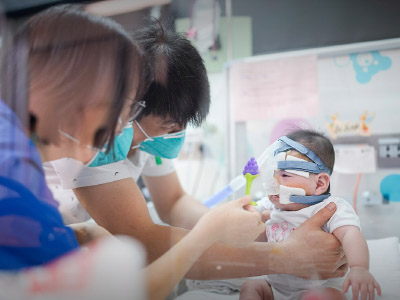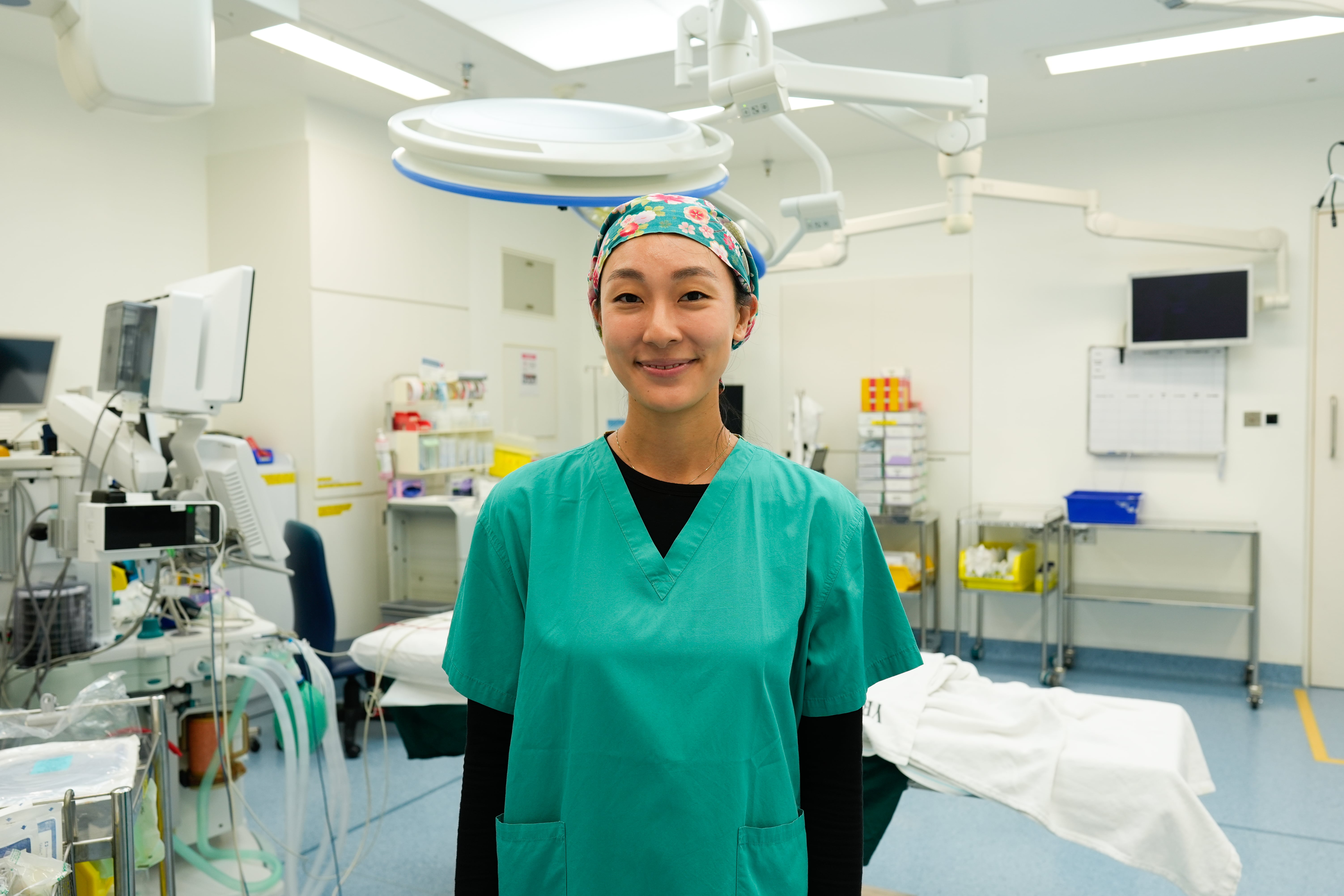What happens when you go for a C-section?
PUBLISHED ON
SCROLL DOWN
Ms Anna Maria Dorrestein, a mother of two, recently welcomed her second child via Caesarean section (C-section).
Ms Dorrestein had initially hoped for a natural birth, like with her firstborn. However, as her pregnancy progressed and the medical team at the National University Hospital (NUH) monitored her condition, a C-section was ultimately recommended as the safer option.
“Ultrasound scans showed a low-lying placenta, blocking Baby’s exit from the vagina. It could also cause severe vaginal bleeding,” said Ms Dorrestein. As this condition heightens the risk of premature birth, her doctor, Prof Mahesh Choolani, Head and Senior Consultant, Department of Obstetrics and Gynaecology, NUH, scheduled the C-section after week 38 of pregnancy, shortly before full term.
“The surgery happened a bit early,” she acknowledged. “But having experienced recurrent miscarriages before, it was in a way a relief. I didn’t have to worry about things going wrong in my final weeks.”
A C-section is typically recommended only if doctors deem a vaginal birth risky to the health of the mother and/or baby. It may be planned (like in Ms Dorrestein’s case) or unplanned (should problems occur during labour).
“We trusted the team at NUH,” said Ms Dorrestein. “They told us all our options and answered all our questions and concerns, right up until just before the operation.”
Likening NUH to a one-stop shop, she elaborated: “Early in my pregnancy, a scan picked up a cyst in my ovary. Another professor was brought in to investigate it. Luckily, the cyst was harmless and eventually disappeared. They also wanted to run some genetic tests and promptly slotted me in for an appointment with a geneticist at NUH.”
Ms Dorrestein’s experience highlights the National University Centre for Women and Children’s (NUWoC) integrated approach to care. Previously, antenatal patients had to navigate multiple referrals across specialties, adding complexity to an already critical journey. To streamline care and support to expectant mothers, NUWoC established the Genetics & Genomics and High-Risk Pregnancy programmes, bringing obstetricians and paediatricians together to provide seamless, comprehensive care for both mother and baby.
“It’s nice that everything is centred here. We benefitted from seamless booking of appointments and continuity of care.”
– Ms Anna Maria Dorrestein
Through frequent checkups, blood tests and scans, it became clear that a C-section was the best course of action for Ms Dorrestein. That was when Prof Mahesh broached the idea of a gentle C-section, where elements of a natural birth are brought into the operating theatre (OT).
In a gentle C-section, there is no change to the surgery itself. The same techniques and safety practices apply. The same team members – comprising obstetricians, nurses, anaesthetists and neonatologists – are also present. What differs is the greater focus on involving parents in the birth, and making the OT a more welcoming environment.
Where medically possible, key elements of a gentle C-section include:
- Playing background music to help the mother feel calm and at ease during the procedure.
- Gently lifting the baby from the womb and delaying clamping of the umbilical cord for at least one minute, to replicate the natural birth process.
- Facilitating skin-to-skin contact between mother and baby in the OT.
- Providing a family-centred experience where the father also has an opportunity for skin-to-skin contact with the baby.
Ms Dorrestein was fully on board with the idea, as it would retain some elements of the natural vaginal birth experience.
“A gentle C-section feels less medical. It encourages more family bonding moments, such as being able to hold Baby and have skin-to-skin contact as soon as possible,” she said. “The delayed cord clamping also allows more blood to flow from the placenta, benefitting Baby.”
For most C-sections, regional anaesthesia is used to numb the lower body while keeping the patient awake. To ensure it is working, the anaesthetist tests sensation by applying ice to the area.
Just before surgery, the medical team cleans the tummy to prevent infection around the incision site.
In a gentle C-section, the baby is slowly eased out of the uterus through a combination of maternal effort and external assistance. The doctor supports the baby’s head and torso as they wriggle out, carefully pulling the baby if needed, while the mother pushes to help the process.
It is normal for the mother to feel some tugging and pulling as her baby is being born. However, according to Dr Teo Wei Wei, Senior Consultant, Department of Anaesthesia, NUH, there should not be any pain.
“The anaesthesia team stays with the mother throughout the C-section, maintaining constant communication and monitoring her condition,” said Dr Teo. “At any point the mother feels discomfort, the surgery will be paused, if feasible. We will then evaluate and address the issue, for instance by offering extra pain relief, before resuming the procedure.”
Trained OT nurses enhance the delivery experience for both the patient and the healthcare team.
At NUH, OT guidelines stipulate that the baby must be quickly examined by the neonatology team before skin-to-skin contact with the mother can begin. OT nurses are trained to receive the baby from the surgeon and assist the neonatal physician in checking the baby’s vital signs, as well as drying, suctioning, weighing and swaddling the newborn. OT nurses are also trained in neonatal resuscitation to ensure the baby’s safety.
The need for neonatal resuscitation at birth can be unpredictable. “Up to 10 per cent of newborns may need help transitioning from a foetus to a breathing newborn with good heart function,” said A/Prof Biswas Agnihotri, Head and Senior Consultant, Department of Neonatology, Khoo Teck Puat – National University Children’s Medical Institute (KTP-NUCMI), NUH.
The neonatology team is available to render support for any eventuality, not just help newborns with breathing problems. “After ensuring a successful transition, we work with parents, nurses, anaesthetists and obstetricians to enable early bonding between the baby and parents through skin-to-skin contact and early breastfeeding,” added A/Prof Biswas. “Our role is to support the baby’s health and wellbeing right after birth, so they start life strong.”
For OT nurses, such upskilling leads to greater job satisfaction. “By expanding our role, OT nurses can contribute more directly to the care process,” shared Ms Joyce Chai, Nurse Clinician, Operating Theatre, NUH. “This shift not only provides nurses with a sense of professional development, but also ensures a more seamless, coordinated approach to childbirth, enhancing the overall experience for mothers and families.”
The first hour or so after birth, known as the ‘Golden Hour’, is crucial in laying the foundation for a strong mother-baby bond.
Early skin-to-skin contact is associated with improved breastfeeding success, bringing nutritional benefits for the newborn. It also regulates their breathing, heart rate, body temperature, blood pressure and blood sugar, and reduces stress for both mother and baby.
"After the umbilical cord is cut, and the placenta is removed, the doctor completes the surgery by closing the incision with stitches (which are usually dissolvable) or staples."
– Prof Mahesh Choolani
The father is also encouraged to play an active role during and after surgery.
During the procedure, the daddy remains by the mummy’s side, offering support and witnessing the birth of their baby. Afterwards, while Mummy recuperates, Daddy can enjoy precious bonding time with Baby. This initial recovery period, typically lasting 30 minutes to one hour, allows for skin-to-skin contact between father and child, strengthening their connection from the very beginning.
Daddy’s skin-to-skin contact with Baby fosters a special bonding moment, strengthening their connection from the start.
A C-section normally takes less than an hour and requires a hospital stay of two to three days. Care continues in the ward, where the healthcare team watches over the mother and baby’s wellbeing. Nurses and lactation consultants are on hand to provide breastfeeding tips and guidance on newborn care.
Patients who have undergone a C-section rather than vaginal birth require a longer time for recovery, and are advised to get ample rest while recuperating at home. During this time, they can enjoy getting to know the newest member of their family and build a lasting bond.
“After all the emotional ups and downs, and having imagined the moment for so long, there were happy tears when I finally got to cuddle Baby in my arms,” said Ms Dorrestein. “Our five-year-old is excited to be a big brother. We can’t wait to create family memories together!”
In consultation with Prof Mahesh Choolani, Head and Senior Consultant, Department of Obstetrics and Gynaecology, NUH; A/Prof Biswas Agnihotri, Head and Senior Consultant, Department of Neonatology, KTP-NUCMI, NUH; Dr Teo Wei Wei, Senior Consultant, Department of Anaesthesia, NUH; and Ms Joyce Chai, Nurse Clinician, Operating Theatre, NUH.
The Department of Obstetrics and Gynaecology and Department of Neonatology, KTP-NUCMI, are part of the National University Centre for Women and Children (NUWoC), a national university specialist centre that aims to empower women, children and their families to lead healthier lives.




